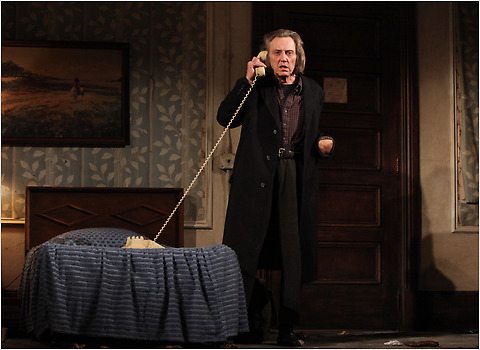New York Times
Theater Talkback: Costume Design
by Ben Brantley on March 10, 2010

Sara Krulwich/The New York Times Christopher Walken in the Martin McDonagh play “A Behanding in Spokane.”
Even before he opens his mouth, you can tell that the central character in Martin McDonagh’s “Behanding in Spokane” is bonkers. Of course, it’s kind of a giveaway that he’s being played by Christopher Walken, that master interpreter of psychos. But look closely at what he’s wearing, and how he’s wearing it. Everything is at least secondhand, and nothing really fits, including that big black coat and those oversize, way-too-short pants. Yet his clothes seem as much a part of him as his skin, or a carapace for an armadillo. This guy lives in those duds and probably has for a long, long time.
In theater, clothes make the man — and woman and child — a fact that we often overlook, especially when the clothes are as understated as those created by Scott Pask for Mr. Walken. When awards are handed out for costume design, it’s usually the fantasy or elaborate period getups that take home the prizes. But recently I’ve been newly aware of the subtleties of less conspicuous attire in defining character onstage, of instances when (to use an old-fashioned cliché) the actors wear the clothes rather than vice versa.
In “The Temperamentals,” Jon Marans’s docudrama about being gay in 1950s America, all the men are in sober suits and at first appear more or less interchangeable. But then you start to notice little details that set them apart from one another, particularly the accessories and especially those telltale neckties. Seeing how the designer Clint Ramos had dressed the actors here, I thought of that ostensibly respectable aristocrat the Baron de Charlus, in Proust’s “Remembrance of Things Past,” whose wardrobe always warrants a second glance because it betrays a lurid other life.
In the Broadway production of Geoffrey Nauffts’s “Next Fall” and the second act of Bruce Norris’s “Clybourne Park,” a recent hit for Playwrights Horizons, everyday contemporary clothes reveal quite a bit about the people inside them, particularly about differences in class and geographical origin. Note the contrasts between what’s worn by the native New Yorkers and by the visitors from Florida in the opening scene of “Next Fall,” which features sociologically exact costumes by Jess Goldstein. Or consider the expensively casual look (designed by Ilona Somogyi) affected by the gentrifying invaders who have just bought a new home in “Clybourne Park.” In both cases, a sartorial basis is laid for conflicts to come.
Uniforms dominate the clothing-scape of Suzan-Lori Parks’s “Book of Grace,” at the Public Theater. The Texan husband and wife at its center are a border guard and a waitress, and the estranged son who returns to visit them wears the uniform of youth: jeans and T-shirt. But the cut, the cleanliness and even the creases of these standard-issue clothes (Susan Hilferty is the costume designer) tell you more about these people than they might want you to know. Not for nothing does ironing play a significant role in this allegorical drama about a divided nation.
The moral here, I suppose, is that, given the right combination of actors and designers (or stylists), a dramatically revealing wardrobe could be assembled from the Gap, Wal-Mart or the Salvation Army. Can you think of other examples of costumes that speak softly but tell all?